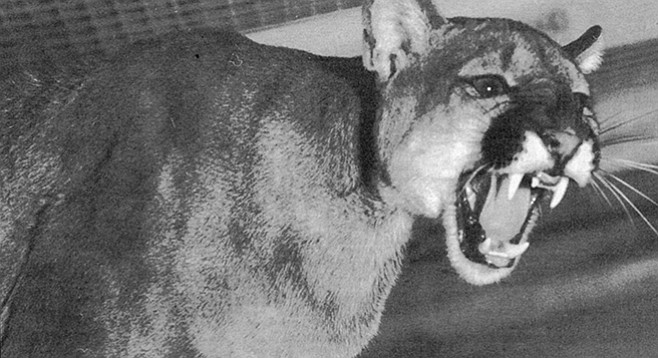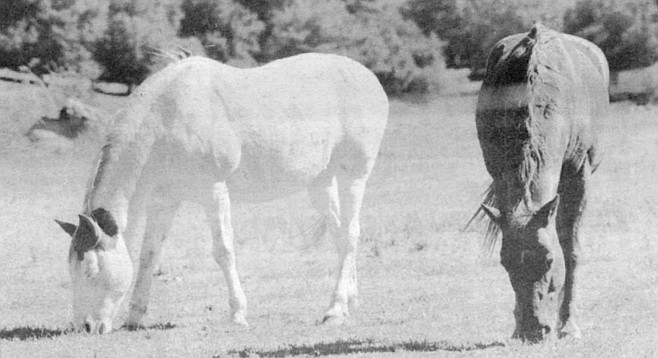 Facebook
Facebook
 X
X
 Instagram
Instagram
 TikTok
TikTok
 Youtube
Youtube

Everyone agrees it was tragic. On September 5, a tracker-hunter under contract with the Animal Damage Control division of the Department of Fish and Game killed four mountain lions — a 70-pound female and her three 14- to 15-month-old offspring — on a private ranch in Julian. According to the ranch owner, the lions had killed one of his foals and injured another horse. The hunter examined the foal and determined that mountain lions were responsible for its death. The following evening he lay in wait near the carcass, and when the four lions returned to snack, he shot them.

"It was a tragedy," said Chuck Traisi of the Fund for Animals Wildlife Rehabilitation Center in Ramona.
"Absolutely tragic," said Lynn Sadler, executive director of the Mountain Lion Foundation in Sacramento.
"It was pretty tragic," said Doug Updike, Large Mammal Program coordinator for the Department of Fish and Game in Sacramento.
Everyone agrees that more mountain lions are going to be killed in the future. No one knows what to do.
Lynn Sadler says, "There's no wonderful solution. You look at the incident in Julian and it's awful — five animals, including the foal, are dead. Something that shouldn't have happened. Something that no one wanted to happen. And yet in some ways it's a paradoxical situation.
"We've found that there's always tremendous spontaneous public outrage around mountain lion killings. This outrage and concern are far greater and more effective than anything an organization like ours could generate on its own. The Department of Fish and Game is aware of this. They know that people go nuts whenever a mountain lion is killed.
"But what people don't realize is that their individual choices have an impact on the environment. You look at San Diego, which is very typical of many parts of California - rapid growth and rapid sprawl. People moving further and further away from the city into areas that were once rural. People want to move into the country, yet they somehow don't understand that their presence is going to have an impact on the animals that live there. New homes disturb or destroy natural habitats. That should really come as no great surprise.
"I understand the Department of Fish and Game's way of thinking on this issue. These lions posed a serious threat. But I can't help wondering why an organization that's in charge of protecting wildlife can't manage to educate people on how to protect their livestock from wildlife."
Doug Updike says that since the late 1980s the department has had materials available that instruct people how to protect their livestock from wildlife. But, he says, the department can't force people to solicit the information or to use it.
"Anyway," he says, "people are encountering mountain lions now in many different kinds of situations, situations that don't always involve livestock. We estimate that today there are between four to six thousand mountain lions in California. Not only are there more and more of them, but their range is increasing. Mountain lions are now common in areas like northeast California where, 15 to 20 years ago, they were never seen.
"Some of this may have to do with the fact that hunting mountain lions was outlawed in 1972, but many other factors come into play - the state's growing population being one of them. In addition to there being more people in the state, people are developing areas that were once wild. They go out into rural areas and start building homes and golf courses and irrigating and planting gardens - doing things that increase the amount of food consistently available to deer, for example. Deer are a mountain lion's main food source. The more deer, the more mountain lions. And since the deer are moving in closer to where humans live, the lions move in closer too. That's one potential factor.
"But you can't really put your finger on one thing and say that's why we're having a huge increase in contact with mountain lions. The numbers we do have are pretty amazing. In 1972, for example, only 4 permits were issued statewide for killing mountain lions that posed a threat to humans or livestock. Compare that with 1994 when 328 permits were issued and 121 were killed. In 1994 in San Diego, 6 were issued and 3 were killed. In 1995, statewide, 331 were issued, 117 killed. In San Diego, 6 issued, 3 killed. In 1996, statewide, 281 permits were issued, 103 killed. In San Diego, 4 were issued, and 2 were killed.
"We don't have stats yet for 1997, but we have this one incident alone in Julian in which four lions were killed. The numbers are clearly growing, and they're growing fast. You have to remember, too, that our numbers don't reflect the lions killed by people who don't bother to get permits, who take the law into their own hands. We have no way of knowing how many that might be. Then there are also cases where law enforcement may have to shoot a lion on the spot if it's posing an immediate threat to humans. We don't have those numbers, either.
"In all likelihood, the number of lions killed will continue to grow. Nobody wants that, but nobody's figured out a way yet for tens of millions of Californians to live with mountain lions in such a way that nobody gets hurt."


Everyone agrees it was tragic. On September 5, a tracker-hunter under contract with the Animal Damage Control division of the Department of Fish and Game killed four mountain lions — a 70-pound female and her three 14- to 15-month-old offspring — on a private ranch in Julian. According to the ranch owner, the lions had killed one of his foals and injured another horse. The hunter examined the foal and determined that mountain lions were responsible for its death. The following evening he lay in wait near the carcass, and when the four lions returned to snack, he shot them.

"It was a tragedy," said Chuck Traisi of the Fund for Animals Wildlife Rehabilitation Center in Ramona.
"Absolutely tragic," said Lynn Sadler, executive director of the Mountain Lion Foundation in Sacramento.
"It was pretty tragic," said Doug Updike, Large Mammal Program coordinator for the Department of Fish and Game in Sacramento.
Everyone agrees that more mountain lions are going to be killed in the future. No one knows what to do.
Lynn Sadler says, "There's no wonderful solution. You look at the incident in Julian and it's awful — five animals, including the foal, are dead. Something that shouldn't have happened. Something that no one wanted to happen. And yet in some ways it's a paradoxical situation.
"We've found that there's always tremendous spontaneous public outrage around mountain lion killings. This outrage and concern are far greater and more effective than anything an organization like ours could generate on its own. The Department of Fish and Game is aware of this. They know that people go nuts whenever a mountain lion is killed.
"But what people don't realize is that their individual choices have an impact on the environment. You look at San Diego, which is very typical of many parts of California - rapid growth and rapid sprawl. People moving further and further away from the city into areas that were once rural. People want to move into the country, yet they somehow don't understand that their presence is going to have an impact on the animals that live there. New homes disturb or destroy natural habitats. That should really come as no great surprise.
"I understand the Department of Fish and Game's way of thinking on this issue. These lions posed a serious threat. But I can't help wondering why an organization that's in charge of protecting wildlife can't manage to educate people on how to protect their livestock from wildlife."
Doug Updike says that since the late 1980s the department has had materials available that instruct people how to protect their livestock from wildlife. But, he says, the department can't force people to solicit the information or to use it.
"Anyway," he says, "people are encountering mountain lions now in many different kinds of situations, situations that don't always involve livestock. We estimate that today there are between four to six thousand mountain lions in California. Not only are there more and more of them, but their range is increasing. Mountain lions are now common in areas like northeast California where, 15 to 20 years ago, they were never seen.
"Some of this may have to do with the fact that hunting mountain lions was outlawed in 1972, but many other factors come into play - the state's growing population being one of them. In addition to there being more people in the state, people are developing areas that were once wild. They go out into rural areas and start building homes and golf courses and irrigating and planting gardens - doing things that increase the amount of food consistently available to deer, for example. Deer are a mountain lion's main food source. The more deer, the more mountain lions. And since the deer are moving in closer to where humans live, the lions move in closer too. That's one potential factor.
"But you can't really put your finger on one thing and say that's why we're having a huge increase in contact with mountain lions. The numbers we do have are pretty amazing. In 1972, for example, only 4 permits were issued statewide for killing mountain lions that posed a threat to humans or livestock. Compare that with 1994 when 328 permits were issued and 121 were killed. In 1994 in San Diego, 6 were issued and 3 were killed. In 1995, statewide, 331 were issued, 117 killed. In San Diego, 6 issued, 3 killed. In 1996, statewide, 281 permits were issued, 103 killed. In San Diego, 4 were issued, and 2 were killed.
"We don't have stats yet for 1997, but we have this one incident alone in Julian in which four lions were killed. The numbers are clearly growing, and they're growing fast. You have to remember, too, that our numbers don't reflect the lions killed by people who don't bother to get permits, who take the law into their own hands. We have no way of knowing how many that might be. Then there are also cases where law enforcement may have to shoot a lion on the spot if it's posing an immediate threat to humans. We don't have those numbers, either.
"In all likelihood, the number of lions killed will continue to grow. Nobody wants that, but nobody's figured out a way yet for tens of millions of Californians to live with mountain lions in such a way that nobody gets hurt."
Comments